Sunday, 23 August 2015: Lisbon to Porto, boarding the Viking Hemming
Written 10 September 2015
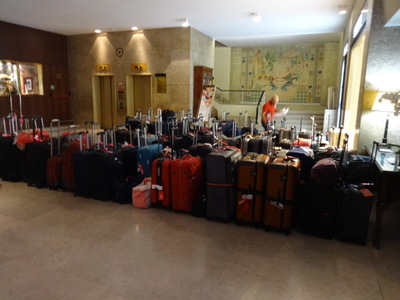
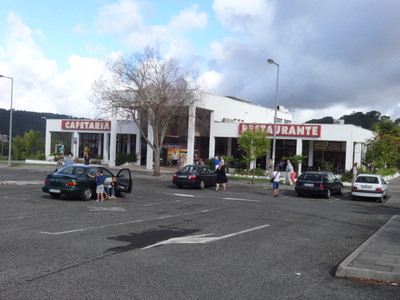 Buz and Kathy were a little fragile this morning—a little too much wine, and Buz's clams didn't agree with him—but David and I met for breakfast at 6:30, leaving our luggage ready in our rooms for pickup. Mine almost didn't get picked up because we had rented a second hotel room independently, and it wasn't listed as being part of the Viking group. Fortunately, tour director Miguel double-checked with me and cleared it up. At the left here, you see him with the luggage herd, makin' his list and checkin' it twice, and blurred by motion. "If you have any questions," he said, "just look around for me; I'm the running red dot."
Buz and Kathy were a little fragile this morning—a little too much wine, and Buz's clams didn't agree with him—but David and I met for breakfast at 6:30, leaving our luggage ready in our rooms for pickup. Mine almost didn't get picked up because we had rented a second hotel room independently, and it wasn't listed as being part of the Viking group. Fortunately, tour director Miguel double-checked with me and cleared it up. At the left here, you see him with the luggage herd, makin' his list and checkin' it twice, and blurred by motion. "If you have any questions," he said, "just look around for me; I'm the running red dot."
Thanks to Miguel's efforts, all our luggage was loaded not just into a bus but into our bus, good old bus C. We piled in as well and headed out toward Porto. At the first turn, as we left Lisbon, David's backpack shot off the overhead rack, and I managed to shoot my hand out and catch it before it hit the floor. All the folks behind us were really impressed! (And David was glad his Kindle was saved the impact.)
Things Maria told us to pass the time on the bus ride.
- Portugal is 35,500 square miles, including Madeira and the Azores, which are considered part of the country.
- People in the northern part of the country show Celtic genetic influence (e.g., blue eyes, light hair and skin) and are conservative and highly Catholic. More African, Moorish, and Jewish genetic influences show up in the south, which is liberal and less Catholic.
- Abortion and gay marriage and adoption are legal.
- Very few marriages actually take place; 68% of marriages end in divorce in the first 10 years, so most people apparently don't bother. The birth rate is very low, 9%.
- 1998 was 500th anniversary of Vasco da Gama's voyage to India round the horn of Africa.
- The endemic forest is oak: holm, French (white?), and cork oaks. Portugal produces 60% of the world's cork.
- The Eucalyptus was introduced (Maria said in the 1930s, but later we were told as early as the 16th century) for use in the paper industry and has gotten seriously out of hand. You see them everywhere now.
- The best table wines are produced in the north; also lots of olives and olive oil.
- Portugal arrived at its current size and extent in 1249.
- Star (Estrella) Mountain is the one really large one in the country. It's inland, near the Spanish border, and at 2000 m is the only one that gets enough snow for winter sports.
- Coastal Portugal has a mild maritime climate year round, with more rain and humidity in the north and drier and milder weather in the south. The interior is more continental and gets more extremes (0 to 40°C).
- Portuguese is the 5th most widely spoken language in the world. The country's second official language is a mixture of Portuguese and Spanish, spoken by about 15,000 people near the border. Maria said she'd never met a speaker or known anyone who had. I never really caught the name of the hybrid language.
- Children start school at age six, and education is compulsary for 12 years. Books and school supplies are purchased by the family; the indigent can apply for reimbursement. Public school is free; private school is better. The opposite is true of universities; the public ones are better, and the private ones are for students who can't get into the public ones. A public university costs about 1100 euros per year, payable in three installments.
- Unemployment is about 15% just now, but that's an underestimate because so many people have left the country to work elsewhere. A million Portuguese work in France. In the past the illiterate emigrated; now it's the university educated who can't find work otherwise.
- The work week is 40 hours. Minimum wage 505 euros/month (ca. $680/mo), 890 euros/month is the average.
- An appartment of 100 m2 (about a one-bedroom) costs about 800 euros/month in the city center, about 450 euros/month in the suburbs.
- The "normal" value-added tax (e.g., in restaurants and for services) is 23% (ouch; an austerity measure implemented after the country's 2011 financial bail-out). It's 13% on taxi and bus fares and 6% on subsistence essentials (water, bread, flour). After the bailout, all taxes were raised, incomes were "sort of" frozen, and benefits were cut; so far the country has kept up with payments and hopes soon to be out of debt and to see improvements in the economy.
- Retirement age is 66 in the private and 63 in the public sector; pensions range from 100s to 1000s of euros depending on all sorts of conditions. The worst-case scenario, e.g., of someone who truck farmed for cash and never paid social security, is about 200–250 euros/month; when your spouse dies, you get another 150 a month.
- Health care is provided for 7–8 euro copay per visit; Maria says the system is improving; expensive private health care is also available, but she uses the public one. Anyone, resident of not, who shows up in need of medical assistance gets it immdiately by law, but they may get a bill later.
- Most people rent their homes (most are urban), but country people often own them.
- Portugal's iconic tragic love story is that of King Pietro I and Inez de Castro.
Besides the ever-present eucalyptus (both naturalized and planted), I saw olives, lindens, pines (maritime and umbrella), sycamores (in the American sense—Platanus, not Acer), palms, sweetgums, poplars, alder, ash, yew, and birch. Lots of oleander, some lantana. Some nonpine conifers, maybe junipers, firs, or spruces. Probably junipers. Some palo-verde-like things.
The olive trees were cultivated in two different patterns—the usual, with rows of freestanding trees with bare trunks, but also in long rows of close-planted trees trimmed into solid hedges, with branches extending to the ground.
I saw a little livestock—sheep, a few golden cows, a horse. A few fields of vines, and what might have been grain fields but already mowed and harvested. A few fields of corn, drying as they stand, and one field of something that could have been sugar beets.
Clumps and rows of cane were everywhere by the roadsides and between fields, but I never saw any that looked cultivated. We passed some fields of dried up sunflowers with their heads nodding.
People were growing citrus and fig trees in their dooryards, and I saw lots of wood pigeons and cattle egrets.
On the way out of Lisbon, we passed a cement factory (the first of many; cement is a major product of the region), an Ikea store, and a Staples store. A large power plant had what looked like cooling towers, but Maria assured us that it is not nuclear; overall Portugal uses 60% renewable energy, some from windmills, but mostly hydroelectric.
She also pointed out the Vasco da Gama bridge, which is many (17?) kilometers long, only 3 km of which is actualy over water.
In the first hour, we passed the shrine of Our Lady of Fatima but did not stop to visit. It draws 4–5 million pilgrims a year In 1917, three children saw apparitions there of the Virgin Mary, several times between May and October. Now the shrine is preparing for the 100th anniversary in 2017. Two of the children died young, before age 10, but the third became a nun and lived to a great age. Pope John Paul II came to visit her in Coimbra (of which more below) in 1982, after he was shot by a would-be assassin on the anniversary (May 13) of the first apparation. He was convince the Virgin Mary's intercession saved his life that day.
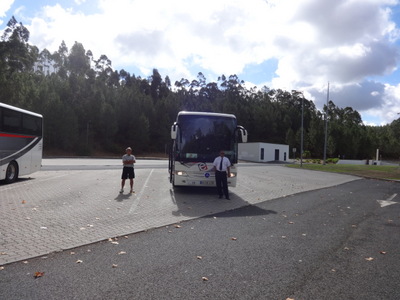
 After an hour and a half on the road, we stopped at a rest area cum restaurant to use the rest rooms. We were given 20 minutes or so to check out the shop and restaurant and to stretch our legs. At the left here is our bus, guarded by our driver so that we could leave all our personal belongings inside without risk. The buses had clearly been chartered for the season by Viking, as each one had a rather worn-looking Viking plaque riveted to the side.
After an hour and a half on the road, we stopped at a rest area cum restaurant to use the rest rooms. We were given 20 minutes or so to check out the shop and restaurant and to stretch our legs. At the left here is our bus, guarded by our driver so that we could leave all our personal belongings inside without risk. The buses had clearly been chartered for the season by Viking, as each one had a rather worn-looking Viking plaque riveted to the side.
The restaurant had what looked like very good roast suckling pig, but we didn't order anything. Kathy bought Portuguese puffy cheetos and shared them around. She's always seeking the cheetos of her youth, which she says didn't taste like those of today. Back then they were just "cheese puffs," and you bought them by the scoop from the candy counter in a department store. These claimed to contain "cheese and ketchup flavors," but they were a better immitation of the American product than the ones in France, which are peanut-butter flavored.

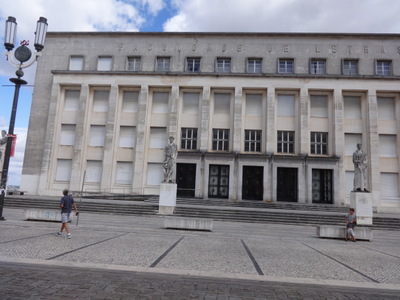 After another hour on the bus, we reached Coimbra, the seat of a very old and very prestigious university and also, from 1155 to 1256, the capital of the country. Fishermen, craftsmen, and merchants lived in the lower part of the town, and the religious orders that dominated the hilltops became the university when King Dennis got permission from the Pope to found it in 1240. Parts of the university date from its founding, like some of the buildings around this square (left-hand photo) which is considered its "historic core," but much of it was torn down and rebuilt in the 1940s by Salazar in slab-sided concrete, like the College of Letters in the right-hand photo. We were told that the clock tower in the left-hand photo, whose bell long governed student life—up at dawn, changes of class, mealtimes, etc.—was long known to the students as the, ahem, female dog.
After another hour on the bus, we reached Coimbra, the seat of a very old and very prestigious university and also, from 1155 to 1256, the capital of the country. Fishermen, craftsmen, and merchants lived in the lower part of the town, and the religious orders that dominated the hilltops became the university when King Dennis got permission from the Pope to found it in 1240. Parts of the university date from its founding, like some of the buildings around this square (left-hand photo) which is considered its "historic core," but much of it was torn down and rebuilt in the 1940s by Salazar in slab-sided concrete, like the College of Letters in the right-hand photo. We were told that the clock tower in the left-hand photo, whose bell long governed student life—up at dawn, changes of class, mealtimes, etc.—was long known to the students as the, ahem, female dog.
Because the university is so much larger now than when it was founded, large parts of it are scattered throughout the town, but we were there to tour the historic sector. An interesting point about Coimbra is that parts of it are built on a "cryptoporticum," a sort of huge stone deck resting on a vaulted crawl space, which the Romans used to level the ground for construction. Arles has one like it, which we never got around to touring when we were there—you could get into it through the basement of the town hall. Apparently the "crawl space" is often quite large and could be used for storage.
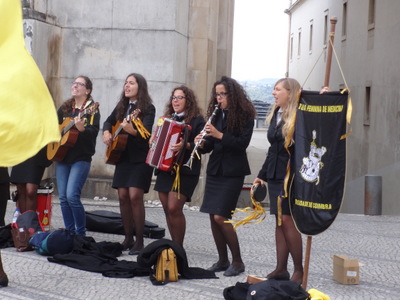
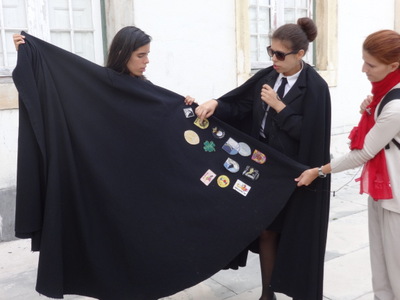 The students at the university form small musical groups called "tunas." At the left is the "Tuna Feminina de Medicina," made up solely of female medical students. While six of them play instruments and sing, a couple more swing and toss large yellow flags—apparently yellow is the color of the College of Medicine. These groups apparently know when tours are due to pass through and play along the tour route for tips.
The students at the university form small musical groups called "tunas." At the left is the "Tuna Feminina de Medicina," made up solely of female medical students. While six of them play instruments and sing, a couple more swing and toss large yellow flags—apparently yellow is the color of the College of Medicine. These groups apparently know when tours are due to pass through and play along the tour route for tips.
Around their feet, among the instrument cases, you see their black capes. Fabiana, our local guide (a university student studying tourism, shown at the right with her student assistant and Maria the tour escort) explained the conventions of the capes. Some wear their capes "traditionally," unadorned, but they also have the option of adding these various patches, which, as I understood it, they cannot purchase for themselves but must receive as gifts from friends and family. Yet another tradition is that, if you're in a relationship, you rip your cape in the center, from the hem upward, with your teeth, to advertise the fact. The depth of the rip indicates the strength of the relationship. If you break up, you have to stitch up the rip. To one side of that center line are smaller rips representing family, and to the other rips representing friends, all made with the teeth. I don't know whether you stitch up Aunt Jane's rip when she dies, or if she disowns you, or what. There's also a whole thing about the colored ribbons, which again you have to earn in some fashion and which you burn on graduation day. All this regalia is traditional but not compulsary.
But the most amazing thing about the capes is that they are the model for the academic dress in the Harry Potter books. J. K. Rowling apparently lived in Portugal for several years, some of it in Coimbra, and borrowed all sorts of things when she assembled Hogwarts.
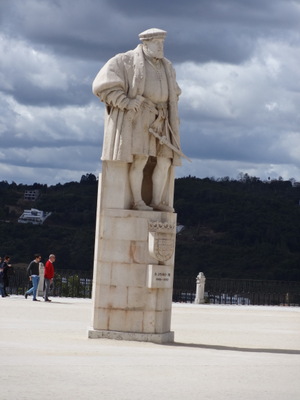
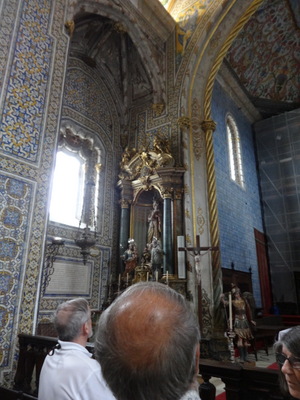 In the middle of the historic square, whch now houses the law school, is this statue of, no, not Henry VIII but João (John) III (1502–1557). The university was founded in 1240, but then it was moved from Coimbra to Lisbon and back several times. I think it was Jo&atilda;o III who finally put a stop to that and settled it definitively in Coimbra by donating his palace there to house it in 1537. The university now includes about 35,000 students, in eight different schools: faculties of medicine, law, letters, techology and science, pharmacy, economy, psychology and educational science, and phys. ed. and sports science. Many degrees take three years; medicine and law take 5–6. Coimbra university is also unusual in that it has sororities and fraternities, rare in Portugal.
In the middle of the historic square, whch now houses the law school, is this statue of, no, not Henry VIII but João (John) III (1502–1557). The university was founded in 1240, but then it was moved from Coimbra to Lisbon and back several times. I think it was Jo&atilda;o III who finally put a stop to that and settled it definitively in Coimbra by donating his palace there to house it in 1537. The university now includes about 35,000 students, in eight different schools: faculties of medicine, law, letters, techology and science, pharmacy, economy, psychology and educational science, and phys. ed. and sports science. Many degrees take three years; medicine and law take 5–6. Coimbra university is also unusual in that it has sororities and fraternities, rare in Portugal.
The twin highlights of the tour were the old university chapel and the magnificent library. The photo at the right shows some of the amazing tile work in the chapel. Unfortunately we weren't allowed to take photos, even without flash, in the library.
Written 9 November 2015:
[So where have I been for two months?! Well, remember back in my first or second entry of this diary, I mentioned that, what with editing jobs, football season, theater season, Christmas baking, etc., I was going to be pretty busy this fall? Well, that was before an elderly relative died (on 15 September) and our name came up on the waiting list of our retirement community of choice, which offered us just the house we wanted (on 28 September). Suddenly, in addition to everything else, I had to travel to Chapel Hill to empty Aunt Alice's appartment and find a home for her cat and to take on all my new duties as executor of her estate. And, in January, we're going to be moving for the first time in 37 years, so I'm running around town looking at paint and flooring samples, getting estimates from movers, getting our current house appraised, haunting the alleys behind liquor stores collecting cardboard boxes, and packing everything in the house that I can lift, all while trying to keep the "front of the house" presentable and normal-looking through Thanksgiving dinner. That's where I've been for two months, and will be for some time to come. But much of it is approaching completion, so between now and our Christmas travel, I hope to get in a little writing time. Thanks for your patience.]
Written 17 November 2015:
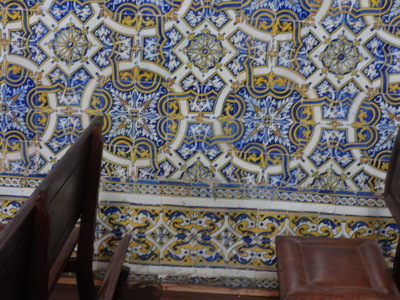
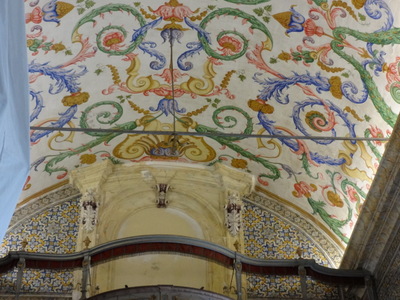 The Chapel of St. Michael, a small portion of which is shown above at the right, features lots of glazed tiles, trompe l'oeuil frescoed ceilings, and gilded wood. Large panels of tile are surrounded by patterned borders, in imitation of tapestries, like the detail shown here at the left. At the right is a section of frescoed ceiling, though not a trompe l'oeil section.
The Chapel of St. Michael, a small portion of which is shown above at the right, features lots of glazed tiles, trompe l'oeuil frescoed ceilings, and gilded wood. Large panels of tile are surrounded by patterned borders, in imitation of tapestries, like the detail shown here at the left. At the right is a section of frescoed ceiling, though not a trompe l'oeil section.
The white object at the left edge of that photo is a drop cloth covering the elaborate pipe organ, which was undergoing repair and restoration. A large photo of it was provided so that tourists could at least see what it looked like.
Over the apse, a fresco of the goddess Minerva was later remodeled as St. Catherine, thought more appropriate for a Catholic university.
João III (the king who built the library) was the son of a king whom many considered to be a usurper of the crown, so all his life, he felt he didn't get the proper respect, and he was a little touchy about it. So when he heard that his father-in-law (the emperor of Austria) had the world's most beautiful library, his immediate reaction was to built a more beautiful one, and the library at Coimbra is it. I wasn't allowed to take photos, but if you Google Images "university coimbra library," you can see many views of it. Besides the magnificent wood and tile work and the huge and beautiful inlaid wooden tables, it includes technical innovations. For example, on the narrow balconies that run around the sides of the room at second-floor level, ladders slide back and forth on tracks to give access to the tall stacks of books. When the ladder isn't needed, you simply slide it to the right position, straighten it up to the vertical, and slide it edgewise into a slot in the wall designed to contain it!
The library is such a popular tourist destination that visits must be scheduled in advance, in 15-minute intervals. Our Quietvox apparatus allowed Viking to run two tours simultaneously in the same interval.
Perhaps the most amazing thing of all about this library is the clever way it has always dealt with potential insect infestations. The tile floors can take care of themselves, but every evening, when the library closes, the staff spread leather covers over the polished inlaid wooden tables so that they will not be marred by droppings from the library's resident colony of bats. The bats—yes, right inside the library—do such a good job at holding down the populations of bookworms, silverfish, and other damaging pests that they can't make a living inside, so they are provided with slots near the ceiling through which they can come and go to forage outside as well.
In the basement of the library is the "academic prison." Rather than have student miscreants mix with the riffraff in the regular jails, the university kept its own prison. The penalty for stealing a library book was six months behind bars. Prisoners were expected to keep up their studies even while confined; friends had to bring them books, notes, etc.

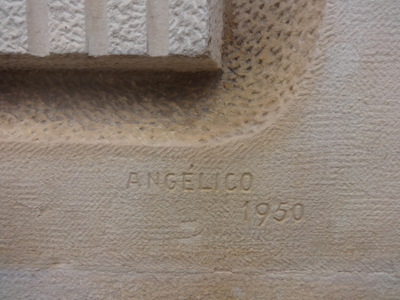 The university's faculty was originally made up of Jesuits, who taught only a restricted range of subjects. The Marquis of Pombal (remember him? prime minister under King Joseph who superintended all that reconstruction after the earthquake of 1755?) felt so strongly that math and science were the coming thing that, in 1759, he expelled the Jesuits and hired secular professors so that those subjects could be taught as well. Here Buz stands next to a relief protraying Charles Darwin (though the building is from the era of Salazar, not that of Pombal). At the right is a close-up of the signature on the relief. It was one of many lining the outside wall of the building. Most of them seemed to be "generic" representations of particular sciences, but we spotted Darwin right away.
The university's faculty was originally made up of Jesuits, who taught only a restricted range of subjects. The Marquis of Pombal (remember him? prime minister under King Joseph who superintended all that reconstruction after the earthquake of 1755?) felt so strongly that math and science were the coming thing that, in 1759, he expelled the Jesuits and hired secular professors so that those subjects could be taught as well. Here Buz stands next to a relief protraying Charles Darwin (though the building is from the era of Salazar, not that of Pombal). At the right is a close-up of the signature on the relief. It was one of many lining the outside wall of the building. Most of them seemed to be "generic" representations of particular sciences, but we spotted Darwin right away.
More facts abouts Coimbra:
- The city's new cathedral is dates from the 1600s; the old one was built in the 1200s.
- The river that runs through Coimbra (the Rio Mondego) is the longest exclusively Portuguese river, that is, the longest that doesn't originate in Spain. Rice is produced in its valley.
- Saint Queen Isabel (yes, a Portuguese queen who is also a saint) is the subject of the city's major annual celebration, around the 4th of July.
- A 16th-century aquaduct (shown here at the right) was built over the old one the Romans built when they occupied the city.

 After our tour of Coimbra and the university, we piled back onto the buses for the 10-minute ride to our lunch restaurant, "Republica da Saudade" ("Republic of Portuguese Mournfulness"). It's a chain but is apparently well thought of and serves authentic Portuguese food.
After our tour of Coimbra and the university, we piled back onto the buses for the 10-minute ride to our lunch restaurant, "Republica da Saudade" ("Republic of Portuguese Mournfulness"). It's a chain but is apparently well thought of and serves authentic Portuguese food.
As we came up the walkway to the front entrance, the staff spread their cloaks on the ground for us to walk on, as a sign of hospitality; our guides on the buses had warned us that this would happen and emphasized that we must actually step on the coaks. Stepping over them would be rude.

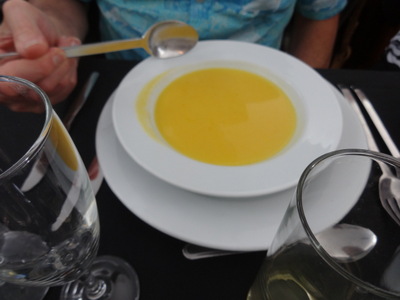 Inside, we were seated at long tables (our party took up most of the restaurant) and served lunch.
Inside, we were seated at long tables (our party took up most of the restaurant) and served lunch.
First course, choice between a salad of tomatos with mozzarella and a creamy vegetable soup. I chose the salad, The tomatoes looked only half ripe but actually had excellent tomato flavor. The soup was one that recurred often during the trip. Portugal apparently only has about four flavors of soup, and this was one of them.
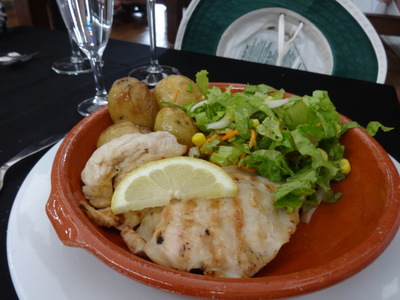
 For the second course, the choice between (a) grilled chicken breast with roasted potatoes and salad and (b) a casserole of salt cod cooked in cream with onions and potatoes with salad. The chicken had been brined and was very good, but the cod casserole, my choice, was excellent!
For the second course, the choice between (a) grilled chicken breast with roasted potatoes and salad and (b) a casserole of salt cod cooked in cream with onions and potatoes with salad. The chicken had been brined and was very good, but the cod casserole, my choice, was excellent!
I can't believe so many people chose the chicken; dried salt cod is the national dish of Portugal, and they prepare it many ways, all delicious. I ordered it at every opportunity, but apparently not everyone shares my enthusiasm.

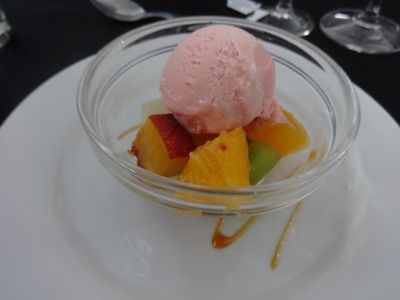 Between courses, we heard "academic" fado. Fado (meaning "destiny" or "fate") is the national music of Portugal. It is full of "saudade" (a brand of mournful nostalgia that Portugal claims for its own) and is almost always sung by women, but academic fado is instead sung by men and apparently deals most often with, in addition to the usual agony of love, the mournful nostalgia of academic life, like courses failed, upcoming exams for which one is hopelessly unprepared, term papers unfairly critiqued, etc.
Between courses, we heard "academic" fado. Fado (meaning "destiny" or "fate") is the national music of Portugal. It is full of "saudade" (a brand of mournful nostalgia that Portugal claims for its own) and is almost always sung by women, but academic fado is instead sung by men and apparently deals most often with, in addition to the usual agony of love, the mournful nostalgia of academic life, like courses failed, upcoming exams for which one is hopelessly unprepared, term papers unfairly critiqued, etc.
The photo at the left shows the singer (the cityscape in the background is a mural). Like all fado ensembles this one consisted of a singer, a regular Spanish guitar, and a 12-stringed "Portuguese guitar," which is teardrop (rather than hour-glass) shaped and apparently evolved from the cittern.
Dessert was house-made strawberry ice cream on a bed of fresh fruit (nectarines, melon, kiwi chunks, orange chunks).
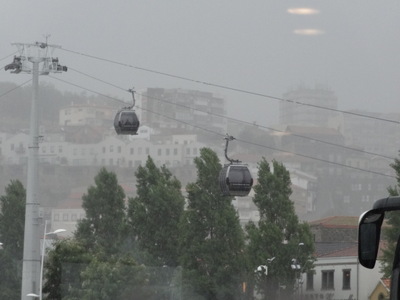
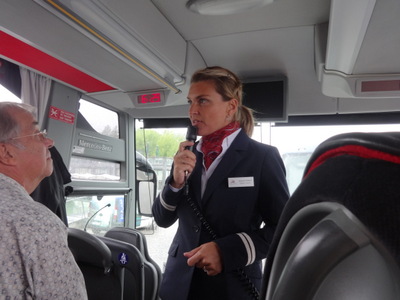 Then it was back on the bus for the remaining hour's drive to Porto and the ship, all in a steady drizzle. The last mile or so down to the river side was absolutely hair-raising Our giant bus filled the tiny street from side to side and could only just barely fit around the many sharp turns. The driver carefully studied the little mirrors mounted on the stone on either side and honked before every turn, to warn the pedestrians, bicycles, and tiny cars that were nonchalantly zooming up the hill, squeezing past us with fractions of inches to spare. The next day, we actually met another bus coming up! Nothing for it then but to back up until we came to a wide enough spot for it to squeeze by. Our driver really earned his money that day!
Then it was back on the bus for the remaining hour's drive to Porto and the ship, all in a steady drizzle. The last mile or so down to the river side was absolutely hair-raising Our giant bus filled the tiny street from side to side and could only just barely fit around the many sharp turns. The driver carefully studied the little mirrors mounted on the stone on either side and honked before every turn, to warn the pedestrians, bicycles, and tiny cars that were nonchalantly zooming up the hill, squeezing past us with fractions of inches to spare. The next day, we actually met another bus coming up! Nothing for it then but to back up until we came to a wide enough spot for it to squeeze by. Our driver really earned his money that day!
Down on the quai, where our ship was moored (actually in Vila Nova de Gaia, across the River Douro from Porto proper), we passed under this cablecar, which took visitors up to a historic church overlooking the city. We had plenty of time to watch it pass back and forth overhead while the police cleared a small traffic jam caused by a fender bender that was blocking our way.
At this point, we said farewell to Miguel and the Lisbon Viking crew. They saw us as far as the ship (the Viking Hemming), introduced us to the shipboard crew, and then took their buses back to Lisbon to meet the next wave of arriving visitors—two Viking ships ply the Douro, so cruises begin both at the weekend and in midweek. Cycling arriving visitors through the three-day and two-night Lisbon segment is therefore a full-time job. Shown here at the right is Alexandra, our tour director for the rest of the cruise. Most of the crew were Portuguese, but Alexandra was French, so we got to try out our French at least a little bit.
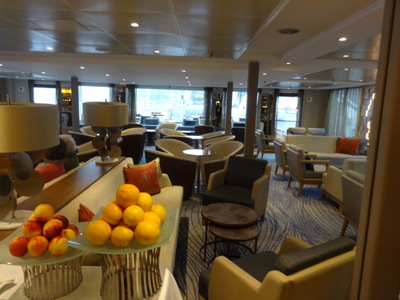
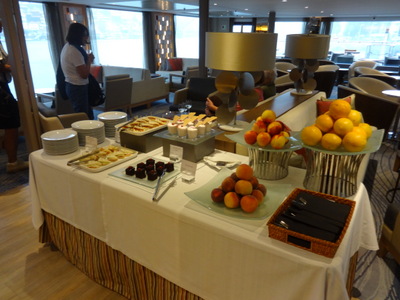 We were directed up the gangway and into the shipboard lounge, where we were served glasses of white port and greeted by this table loaded with finger sandwiches, sweets, and fruit. (All week, whenever we reboarded the ship from any outing, we were served a glass of something, but this "welcoming cocktail" was more elaborate than most.) While we sipped and munched, waiters circulated with canapes—quail egg on herb butter on a crouton, tomato and feta on a porcelain spoon, small bacon-wrapped prunes, and salmon with cream cheese on pumpernickle croutons. Meanwhile, our luggage was being shifted from the buses to our staterooms, and we were called up to the reception desk in small groups to be registered and checked in.
We were directed up the gangway and into the shipboard lounge, where we were served glasses of white port and greeted by this table loaded with finger sandwiches, sweets, and fruit. (All week, whenever we reboarded the ship from any outing, we were served a glass of something, but this "welcoming cocktail" was more elaborate than most.) While we sipped and munched, waiters circulated with canapes—quail egg on herb butter on a crouton, tomato and feta on a porcelain spoon, small bacon-wrapped prunes, and salmon with cream cheese on pumpernickle croutons. Meanwhile, our luggage was being shifted from the buses to our staterooms, and we were called up to the reception desk in small groups to be registered and checked in.
After freshening up in our staterooms, we reported back to the lounge for life-vest instruction and the daily briefing on the next day's activities, and then it was time for cocktails and dinner. Except for the life-vest instruction, which we only had to do the once, this was the pattern each day—cocktails in the lounge, daily briefing (living up to its name in being very brief), then downstairs to dinner.
Amuse-bouche: cold chicken and banana tart. Each of us got half of a chubby little round tart proportioned about like British pork pie.

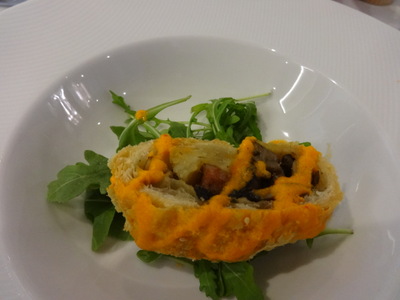 This first night, the first course was served at the tables. David chose green pea soup, which was excellent. I had mushrooms and chorizo in puff pastry, served cold with red bell pepper sauce on a bed of arugula.
This first night, the first course was served at the tables. David chose green pea soup, which was excellent. I had mushrooms and chorizo in puff pastry, served cold with red bell pepper sauce on a bed of arugula.
The other choices were marinated mussels on the half shell with balsamic-pineapple vinaigrette and salade niçla;oise.
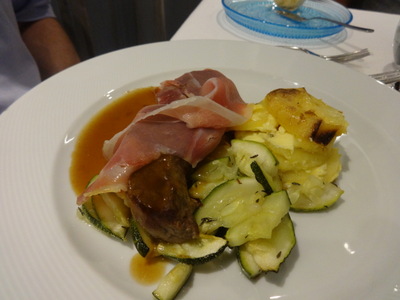
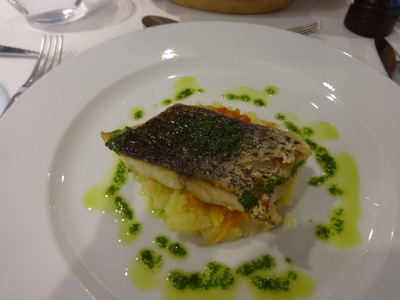 Main course, David: grilled steak topped with raw ham and a port sauce, with gratin dauphinois (French scallopped potatoes) and zucchini.
Main course, David: grilled steak topped with raw ham and a port sauce, with gratin dauphinois (French scallopped potatoes) and zucchini.
Main course, me: Corvina (Argyrosomus regius, official English name: meagre) roasted with onion and tomato and served on crushed potatoes. Yummy.
The third choice was penne pasta with julienne vegetables and tomato sauce. In addition to all these choices, a "permanent" menu was provided for the less adventurous. No matter what else was offered, you could always order a Caesar salad and a roasted chicken breast, a grilled steak, or broiled salmon. This first night and frequently thereafter, Kathy ordered the Caesar salad, a favorite of hers. She was not thrilled with the three large anchovies that came draped over each serving, but we quickly fell into the pattern of transferring two of them to Buz's plate and the third to mine, while David leaned away to avoid any possible contamination.
Between the main course and dessert, we ordered a single cheese plate for the table. It consisted of two cheeses, flamenco and and a Chaource-like brebis. Portuguese cheese turned out to be good but of limited variety.
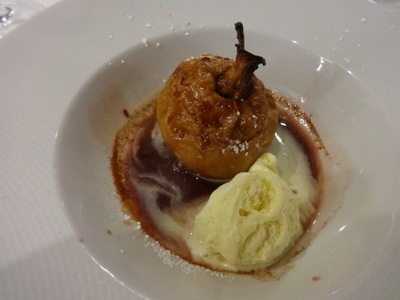
 Dessert, both: Roasted apple with port sauce and vanilla ice cream; excellent. The "Stem" of the apple is part of a cinnamon stick and part of a vanilla bean. Kathy opted instead for chocolate ice cream; mango sorbet was also available.
Dessert, both: Roasted apple with port sauce and vanilla ice cream; excellent. The "Stem" of the apple is part of a cinnamon stick and part of a vanilla bean. Kathy opted instead for chocolate ice cream; mango sorbet was also available.
Throughout the cruise, the food was very good. In fact, in our first on-board briefing, tour director Alexandra said, "Prepare to gain weight; it's one of our goals."
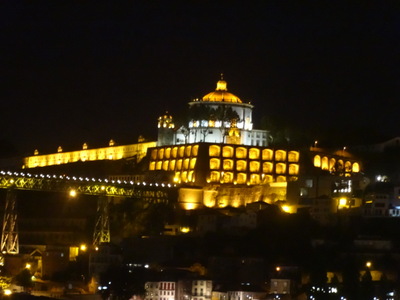 After dinner, the ship cast off and took us on a "surprise" cruise (i.e., an excursion not usually included in the program) down the river to the Atlantic, back up past Porto, and then back down to our original mooring. From there, I got this shot of the church on the hill to which the cable car led. The church itself is round. During mass, the priest stands in the middle, surrounded by the congregation. It's still an active church, but the army now occupies all its monastic buildings. The cloister is also round.
After dinner, the ship cast off and took us on a "surprise" cruise (i.e., an excursion not usually included in the program) down the river to the Atlantic, back up past Porto, and then back down to our original mooring. From there, I got this shot of the church on the hill to which the cable car led. The church itself is round. During mass, the priest stands in the middle, surrounded by the congregation. It's still an active church, but the army now occupies all its monastic buildings. The cloister is also round.
Breakfast at 7 a.m. tomorrow (earlier than usual, taking advantage of the jet lag that would wake most of the passengers early), then off on a city tour, port lodge tour, and port tasting.
Previous entry
List of Entries
Next entry

 Buz and Kathy were a little fragile this morning—a little too much wine, and Buz's clams didn't agree with him—but David and I met for breakfast at 6:30, leaving our luggage ready in our rooms for pickup. Mine almost didn't get picked up because we had rented a second hotel room independently, and it wasn't listed as being part of the Viking group. Fortunately, tour director Miguel double-checked with me and cleared it up. At the left here, you see him with the luggage herd, makin' his list and checkin' it twice, and blurred by motion. "If you have any questions," he said, "just look around for me; I'm the running red dot."
Buz and Kathy were a little fragile this morning—a little too much wine, and Buz's clams didn't agree with him—but David and I met for breakfast at 6:30, leaving our luggage ready in our rooms for pickup. Mine almost didn't get picked up because we had rented a second hotel room independently, and it wasn't listed as being part of the Viking group. Fortunately, tour director Miguel double-checked with me and cleared it up. At the left here, you see him with the luggage herd, makin' his list and checkin' it twice, and blurred by motion. "If you have any questions," he said, "just look around for me; I'm the running red dot."
 After an hour and a half on the road, we stopped at a rest area cum restaurant to use the rest rooms. We were given 20 minutes or so to check out the shop and restaurant and to stretch our legs. At the left here is our bus, guarded by our driver so that we could leave all our personal belongings inside without risk. The buses had clearly been chartered for the season by Viking, as each one had a rather worn-looking Viking plaque riveted to the side.
After an hour and a half on the road, we stopped at a rest area cum restaurant to use the rest rooms. We were given 20 minutes or so to check out the shop and restaurant and to stretch our legs. At the left here is our bus, guarded by our driver so that we could leave all our personal belongings inside without risk. The buses had clearly been chartered for the season by Viking, as each one had a rather worn-looking Viking plaque riveted to the side.
 After another hour on the bus, we reached Coimbra, the seat of a very old and very prestigious university and also, from 1155 to 1256, the capital of the country. Fishermen, craftsmen, and merchants lived in the lower part of the town, and the religious orders that dominated the hilltops became the university when King Dennis got permission from the Pope to found it in 1240. Parts of the university date from its founding, like some of the buildings around this square (left-hand photo) which is considered its "historic core," but much of it was torn down and rebuilt in the 1940s by Salazar in slab-sided concrete, like the College of Letters in the right-hand photo. We were told that the clock tower in the left-hand photo, whose bell long governed student life—up at dawn, changes of class, mealtimes, etc.—was long known to the students as the, ahem, female dog.
After another hour on the bus, we reached Coimbra, the seat of a very old and very prestigious university and also, from 1155 to 1256, the capital of the country. Fishermen, craftsmen, and merchants lived in the lower part of the town, and the religious orders that dominated the hilltops became the university when King Dennis got permission from the Pope to found it in 1240. Parts of the university date from its founding, like some of the buildings around this square (left-hand photo) which is considered its "historic core," but much of it was torn down and rebuilt in the 1940s by Salazar in slab-sided concrete, like the College of Letters in the right-hand photo. We were told that the clock tower in the left-hand photo, whose bell long governed student life—up at dawn, changes of class, mealtimes, etc.—was long known to the students as the, ahem, female dog.
 The students at the university form small musical groups called "tunas." At the left is the "Tuna Feminina de Medicina," made up solely of female medical students. While six of them play instruments and sing, a couple more swing and toss large yellow flags—apparently yellow is the color of the College of Medicine. These groups apparently know when tours are due to pass through and play along the tour route for tips.
The students at the university form small musical groups called "tunas." At the left is the "Tuna Feminina de Medicina," made up solely of female medical students. While six of them play instruments and sing, a couple more swing and toss large yellow flags—apparently yellow is the color of the College of Medicine. These groups apparently know when tours are due to pass through and play along the tour route for tips.
 In the middle of the historic square, whch now houses the law school, is this statue of, no, not Henry VIII but João (John) III (1502–1557). The university was founded in 1240, but then it was moved from Coimbra to Lisbon and back several times. I think it was Jo&atilda;o III who finally put a stop to that and settled it definitively in Coimbra by donating his palace there to house it in 1537. The university now includes about 35,000 students, in eight different schools: faculties of medicine, law, letters, techology and science, pharmacy, economy, psychology and educational science, and phys. ed. and sports science. Many degrees take three years; medicine and law take 5–6. Coimbra university is also unusual in that it has sororities and fraternities, rare in Portugal.
In the middle of the historic square, whch now houses the law school, is this statue of, no, not Henry VIII but João (John) III (1502–1557). The university was founded in 1240, but then it was moved from Coimbra to Lisbon and back several times. I think it was Jo&atilda;o III who finally put a stop to that and settled it definitively in Coimbra by donating his palace there to house it in 1537. The university now includes about 35,000 students, in eight different schools: faculties of medicine, law, letters, techology and science, pharmacy, economy, psychology and educational science, and phys. ed. and sports science. Many degrees take three years; medicine and law take 5–6. Coimbra university is also unusual in that it has sororities and fraternities, rare in Portugal.
 The Chapel of St. Michael, a small portion of which is shown above at the right, features lots of glazed tiles, trompe l'oeuil frescoed ceilings, and gilded wood. Large panels of tile are surrounded by patterned borders, in imitation of tapestries, like the detail shown here at the left. At the right is a section of frescoed ceiling, though not a trompe l'oeil section.
The Chapel of St. Michael, a small portion of which is shown above at the right, features lots of glazed tiles, trompe l'oeuil frescoed ceilings, and gilded wood. Large panels of tile are surrounded by patterned borders, in imitation of tapestries, like the detail shown here at the left. At the right is a section of frescoed ceiling, though not a trompe l'oeil section.
 The university's faculty was originally made up of Jesuits, who taught only a restricted range of subjects. The Marquis of Pombal (remember him? prime minister under King Joseph who superintended all that reconstruction after the earthquake of 1755?) felt so strongly that math and science were the coming thing that, in 1759, he expelled the Jesuits and hired secular professors so that those subjects could be taught as well. Here Buz stands next to a relief protraying Charles Darwin (though the building is from the era of Salazar, not that of Pombal). At the right is a close-up of the signature on the relief. It was one of many lining the outside wall of the building. Most of them seemed to be "generic" representations of particular sciences, but we spotted Darwin right away.
The university's faculty was originally made up of Jesuits, who taught only a restricted range of subjects. The Marquis of Pombal (remember him? prime minister under King Joseph who superintended all that reconstruction after the earthquake of 1755?) felt so strongly that math and science were the coming thing that, in 1759, he expelled the Jesuits and hired secular professors so that those subjects could be taught as well. Here Buz stands next to a relief protraying Charles Darwin (though the building is from the era of Salazar, not that of Pombal). At the right is a close-up of the signature on the relief. It was one of many lining the outside wall of the building. Most of them seemed to be "generic" representations of particular sciences, but we spotted Darwin right away. 
 After our tour of Coimbra and the university, we piled back onto the buses for the 10-minute ride to our lunch restaurant, "Republica da Saudade" ("Republic of Portuguese Mournfulness"). It's a chain but is apparently well thought of and serves authentic Portuguese food.
After our tour of Coimbra and the university, we piled back onto the buses for the 10-minute ride to our lunch restaurant, "Republica da Saudade" ("Republic of Portuguese Mournfulness"). It's a chain but is apparently well thought of and serves authentic Portuguese food.
 Inside, we were seated at long tables (our party took up most of the restaurant) and served lunch.
Inside, we were seated at long tables (our party took up most of the restaurant) and served lunch.
 For the second course, the choice between (a) grilled chicken breast with roasted potatoes and salad and (b) a casserole of salt cod cooked in cream with onions and potatoes with salad. The chicken had been brined and was very good, but the cod casserole, my choice, was excellent!
For the second course, the choice between (a) grilled chicken breast with roasted potatoes and salad and (b) a casserole of salt cod cooked in cream with onions and potatoes with salad. The chicken had been brined and was very good, but the cod casserole, my choice, was excellent!
 Between courses, we heard "academic" fado. Fado (meaning "destiny" or "fate") is the national music of Portugal. It is full of "saudade" (a brand of mournful nostalgia that Portugal claims for its own) and is almost always sung by women, but academic fado is instead sung by men and apparently deals most often with, in addition to the usual agony of love, the mournful nostalgia of academic life, like courses failed, upcoming exams for which one is hopelessly unprepared, term papers unfairly critiqued, etc.
Between courses, we heard "academic" fado. Fado (meaning "destiny" or "fate") is the national music of Portugal. It is full of "saudade" (a brand of mournful nostalgia that Portugal claims for its own) and is almost always sung by women, but academic fado is instead sung by men and apparently deals most often with, in addition to the usual agony of love, the mournful nostalgia of academic life, like courses failed, upcoming exams for which one is hopelessly unprepared, term papers unfairly critiqued, etc.
 Then it was back on the bus for the remaining hour's drive to Porto and the ship, all in a steady drizzle. The last mile or so down to the river side was absolutely hair-raising Our giant bus filled the tiny street from side to side and could only just barely fit around the many sharp turns. The driver carefully studied the little mirrors mounted on the stone on either side and honked before every turn, to warn the pedestrians, bicycles, and tiny cars that were nonchalantly zooming up the hill, squeezing past us with fractions of inches to spare. The next day, we actually met another bus coming up! Nothing for it then but to back up until we came to a wide enough spot for it to squeeze by. Our driver really earned his money that day!
Then it was back on the bus for the remaining hour's drive to Porto and the ship, all in a steady drizzle. The last mile or so down to the river side was absolutely hair-raising Our giant bus filled the tiny street from side to side and could only just barely fit around the many sharp turns. The driver carefully studied the little mirrors mounted on the stone on either side and honked before every turn, to warn the pedestrians, bicycles, and tiny cars that were nonchalantly zooming up the hill, squeezing past us with fractions of inches to spare. The next day, we actually met another bus coming up! Nothing for it then but to back up until we came to a wide enough spot for it to squeeze by. Our driver really earned his money that day!
 We were directed up the gangway and into the shipboard lounge, where we were served glasses of white port and greeted by this table loaded with finger sandwiches, sweets, and fruit. (All week, whenever we reboarded the ship from any outing, we were served a glass of something, but this "welcoming cocktail" was more elaborate than most.) While we sipped and munched, waiters circulated with canapes—quail egg on herb butter on a crouton, tomato and feta on a porcelain spoon, small bacon-wrapped prunes, and salmon with cream cheese on pumpernickle croutons. Meanwhile, our luggage was being shifted from the buses to our staterooms, and we were called up to the reception desk in small groups to be registered and checked in.
We were directed up the gangway and into the shipboard lounge, where we were served glasses of white port and greeted by this table loaded with finger sandwiches, sweets, and fruit. (All week, whenever we reboarded the ship from any outing, we were served a glass of something, but this "welcoming cocktail" was more elaborate than most.) While we sipped and munched, waiters circulated with canapes—quail egg on herb butter on a crouton, tomato and feta on a porcelain spoon, small bacon-wrapped prunes, and salmon with cream cheese on pumpernickle croutons. Meanwhile, our luggage was being shifted from the buses to our staterooms, and we were called up to the reception desk in small groups to be registered and checked in.
 This first night, the first course was served at the tables. David chose green pea soup, which was excellent. I had mushrooms and chorizo in puff pastry, served cold with red bell pepper sauce on a bed of arugula.
This first night, the first course was served at the tables. David chose green pea soup, which was excellent. I had mushrooms and chorizo in puff pastry, served cold with red bell pepper sauce on a bed of arugula.
 Main course, David: grilled steak topped with raw ham and a port sauce, with gratin dauphinois (French scallopped potatoes) and zucchini.
Main course, David: grilled steak topped with raw ham and a port sauce, with gratin dauphinois (French scallopped potatoes) and zucchini.
 Dessert, both: Roasted apple with port sauce and vanilla ice cream; excellent. The "Stem" of the apple is part of a cinnamon stick and part of a vanilla bean. Kathy opted instead for chocolate ice cream; mango sorbet was also available.
Dessert, both: Roasted apple with port sauce and vanilla ice cream; excellent. The "Stem" of the apple is part of a cinnamon stick and part of a vanilla bean. Kathy opted instead for chocolate ice cream; mango sorbet was also available. After dinner, the ship cast off and took us on a "surprise" cruise (i.e., an excursion not usually included in the program) down the river to the Atlantic, back up past Porto, and then back down to our original mooring. From there, I got this shot of the church on the hill to which the cable car led. The church itself is round. During mass, the priest stands in the middle, surrounded by the congregation. It's still an active church, but the army now occupies all its monastic buildings. The cloister is also round.
After dinner, the ship cast off and took us on a "surprise" cruise (i.e., an excursion not usually included in the program) down the river to the Atlantic, back up past Porto, and then back down to our original mooring. From there, I got this shot of the church on the hill to which the cable car led. The church itself is round. During mass, the priest stands in the middle, surrounded by the congregation. It's still an active church, but the army now occupies all its monastic buildings. The cloister is also round.